#enthusiastic entomology
Text


[ID: First GIF is a swift 8-frame walk cycle of a stylized scorpion with a cactus character riding on its back. The cactus is wearing a cape and wide-brimmed hat on its back; the scorpion has an umbrella-shaped sun shade tied to its stinger. All of this and a jar secured behind the cactus' chair jiggles with the scorpion's walk.
Second GIF is a sequence of renders showing the characters' progression through improved textures on the scorpion, stably rigged spines on the cactus, dangling ties on the umbrella's straps, and finally some texture details on the cape and hat. End ID]
As of last night, the flask is the only thing modeled that I haven't rigged yet! (Mostly because I haven't gathered the references to decide how to attach its strap, since it's not visible but implied in Nicholas Kole's concept. Not yet modeled are the grain sack, the reins, and the umbrella's jewelry at the very least. But who's counting?) (I am. There are at least 27 more items on my to-do list for this project; most are not granular.) Even got the umbrella under a regular rig instead of fabric simulation. And the textures are steadily shaping up.
53 notes
·
View notes
Text
i see people saying eddie would be scared of bugs which baffles me. to me that guy is a bug guy. a critter enjoyer. he sees a house centipede on the floor and says “FUCK YEAH.” and picks it up in his hands to look at it
#someone will enter a room freaking out about a huge spider in the bathroom and eddie is always the one to go get it and take it outside#a little beetle crawling on the stairs outside his and Wayne’s trailer? best day ever#TO ME. TO ME EDDIE IS AN ENTOMOLOGY ENTHUSIAST
41 notes
·
View notes
Text
Gardenia

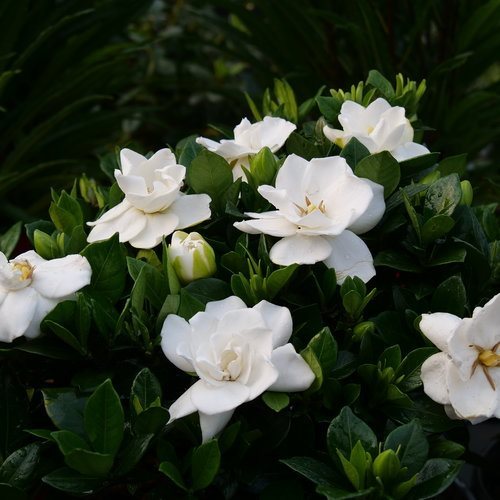
The gardenia (genus) is a flower that symbolizes purity and gentleness. However, this symbolism often depends on the color of the gardenia. For example, the white gardenia best fits this meaning. Another symbol of the gardenia is secret love between two people and also joy. Finally, we must note that the gardenia symbolizes everything related to the spiritual world, especially pure attraction. It’s a mystical flower associated with the power of attraction and positive energy.
Amazing facts about gardenia flower
Gardenia is a genus of flowering plants in the coffee family, Rubiaceae, native to the tropical and subtropical regions of Africa, Asia, Madagascar and Pacific Islands, and Australia.
The genus was named by Carl Linnaeus and John Ellis after Alexander Garden (1730–1791),
Cultivation :
Gardenia jasminoides is cultivated as a house plant. This species can be difficult to grow because it originated in warm humid tropical areas. It demands high humidity to thrive, and bright (not direct) light. at least 6-8 hours of direct sunlight through a sunny window. Make sure your Gardenia soil is moist and well-drained. Gardenias need at least 1 inch of rain (or equivalent watering) each week. Gardenia (Gardenia jasminoides) is also known as cape jasmine and is an evergreen shrub that typically grows to a height of 3 to 8 feet, depending upon the cultivar. Spread is usually about the same as the height. The foliage of well-fed shrubs is glossy, dark-green, 2- to 4-inches long and half as wide. Flowering is from about mid-spring to mid-summer, and many species are strongly scented.
Description :
Gardenias are evergreen shrubs and small trees growing to 1–15 metres (3.3–49.2 ft) tall. The leaves are opposite or in whorls of three or four, 5–50 centimetres (2.0–19.7 in) long and 3–25 centimetres (1.2–9.8 in) broad, dark green and glossy with a leathery texture.
Scent of gardenia:
gardenia smells more feminine than jasmine, creamier than ylang ylang, and lighter than tuberose. Interestingly, the gardenia flower is capable of changing scents throughout the day.Their long lasting, fragrant white flowers bloom from late spring to fall.
History of :
In France, gardenias are the flower traditionally worn by men as boutonnière when in evening dress. In The Age of Innocence, Edith Wharton suggests it was customary for upper-class men from New York City to wear a gardenia in their buttonhole during the Gilded Age.
In Tiki culture, "Donn Beach", aka Don the Beachcomber, frequently wore a fresh lei of gardenias almost every day at his Tiki bars, allegedly spending $7,800 for flowers over the course of four years in 1938. He named one of his drinks the Mystery Gardenia cocktail. Trader Vic frequently used the gardenia as a flower garnish in his Tiki drinks, such as in the Scorpion and Outrigger Tiara cocktails.
main features of the gardenia:
The gardenia has large, lush leaves.
There are many varieties of this plant species.
Gardenias are originally from Asia.
Meaning behind white gardenia :
the white gardenia stands out because it has the greatest symbolism. The white color of its petals symbolizes the purity of a loved one, the purity of a relationship, etc. Gardenias in this color convey peace and harmony

Meaning behind red gardenia:
The red gardenia symbolizes the secret love between two people. Like red roses, red gardenias are also a symbol of passion and love, but associated with secrecy. Usually the gift of red gardenias is a silent way of saying “I love you.” Red gardenias convey several feelings, not just love, towards a person. They also show: admiration, respect, Red Gardenia flower meaning- Affection for deep love and promises is all we need in life. The Red Gardenia symbolizes love at first sight. etc.

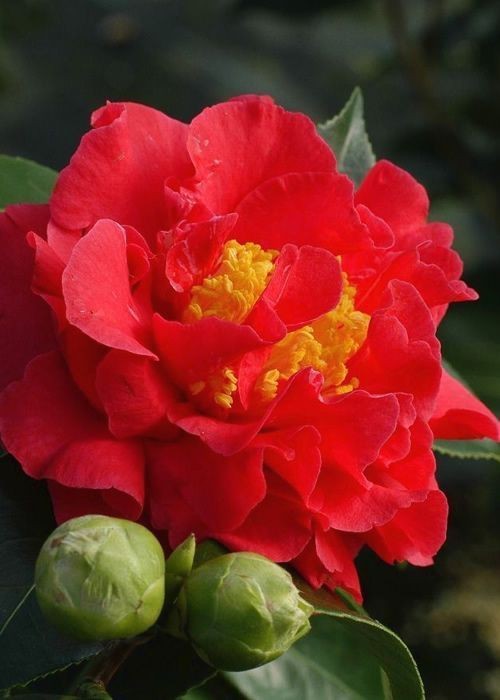
Yellow Gardenia flower meaning- How about having a sweet memory of someone unconsciously? The Yellow gardenias flowers symbolize dreams.
Orange Gardenia flower meaning- Every person deserves someone who can be there every time. The Orange gardenia flowers symbolize hope.
Pink Gardenia flowers meaning- What’s better than giving a fresh start in any relationship? Pink gardenia flowers symbolize beauty and renewal.
128 species in this genus, as follows:
Gardenia actinocarpa Puttock
Gardenia anapetes A.C.Sm.
Gardenia angkorensis Pit.
Gardenia annamensis Pit.
Gardenia aqualla Stapf & Hutch.
Gardenia archboldiana Merr. & L.M.Perry
Gardenia aubryi Vieill.
Gardenia barnesii Merr.
Gardenia beamanii Y.W.Low
Gardenia boninensis (Nakai) Tuyama ex T.Yamaz.
Gardenia brachythamnus (K.Schum.) Launert
Gardenia brevicalyx Rakoton. & A.P.Davis
Gardenia brighamii H.Mann
Gardenia buffalina (Lour.) Poir.
Gardenia cambodiana Pit.
Gardenia candida A.C.Sm.
Gardenia carinata Wall. ex Roxb.
Gardenia carstensensis Wernham
Gardenia chanii Y.W.Low
Gardenia chevalieri Pit.
Gardenia clemensiae Merr. & L.M.Perry
Gardenia collinsiae Craib
Gardenia cornuta Hemsl.
Gardenia coronaria Banks
Gardenia costulata Ridl.
Gardenia crameri Tirveng.
Gardenia cuneata Kurz
Gardenia dacryoides A.Cunn. ex Puttock
Gardenia elata Ridl.
Gardenia epiphytica Jongkind
Gardenia erubescens Stapf & Hutch.
Gardenia esculenta Stokes
Gardenia ewartii Puttock
Gardenia faucicola Puttock
Gardenia fiorii Chiov.
Gardenia flava (Lour.) Poir.
Gardenia fosbergii Tirveng.
Gardenia fucata R.Br. ex Benth.
Gardenia fusca E.T.Geddes
Gardenia gardneri Puttock
Gardenia gjellerupii Valeton
Gardenia gordonii Baker
Gardenia grievei Horne ex Baker
Gardenia griffithii Hook.f.
Gardenia gummifera L.f.
Gardenia hageniana Gilli
Gardenia hainanensis Merr.
Gardenia hansemannii K.Schum.
Gardenia hillii Horne ex Baker
Gardenia hutchinsoniana Turrill
Gardenia imperialis K.Schum.
Gardenia invaginata Merr. & L.M.Perry
Gardenia ixorifolia R.Br. ex Hook.f.
Gardenia jabiluka Puttock
Gardenia jasminoides J.Ellis
Gardenia kabaenensis Y.W.Low
Gardenia kakaduensis Puttock
Gardenia kamialiensis Takeuchi
Gardenia lacciflua K.Krause
Gardenia lamingtonii F.M.Bailey
Gardenia lanutoo Reinecke
Gardenia latifolia Aiton
Gardenia leopoldiana De Wild. & T.Durand
Gardenia leschenaultii D.Dietr.
Gardenia longistipula Y.W.Low
Gardenia magnifica E.T.Geddes
Gardenia mannii H.St.John & Kuykendall
Gardenia manongarivensis Rakoton. & A.P.Davis
Gardenia maugaloae Lauterb.
Gardenia megasperma F.Muell.
Gardenia moszkowskii Valeton
Gardenia mutabilis Reinw. ex Blume
Gardenia nitida Hook.
Gardenia obtusifolia Roxb. ex Hook.f.
Gardenia ornata K.M.Wong
Gardenia oudiepe Vieill.
Gardenia ovularis F.M.Bailey
Gardenia pallens Merr. & L.M.Perry
Gardenia panduriformis Pierre ex Pit.
Gardenia papuana F.M.Bailey
Gardenia philastrei Pierre ex Pit.
Gardenia posoquerioides S.Moore
Gardenia propinqua Lindl.
Gardenia psidioides Puttock
Gardenia pterocalyx Valeton
Gardenia pyriformis A.Cunn. ex Benth.
Gardenia racemulosa Korth.
Gardenia reflexisepala N.H.Xia & X.E.Ye
Gardenia reinwardtiana Blume
Gardenia remyi H.Mann
Gardenia resinifera Roth
Gardenia resiniflua Hiern
Gardenia resinosa F.Muell.
Gardenia rupicola Puttock
Gardenia rutenbergiana (Baill. ex Vatke) J.-F.Leroy
Gardenia sambiranensis Rakoton. & A.P.Davis
Gardenia saxatilis E.T.Geddes
Gardenia scabrella Puttock
Gardenia schlechteri Bonati & Petitm.
Gardenia schwarzii Puttock
Gardenia sericea Puttock
Gardenia similis (Craib) Craib
Gardenia siphonocalyx Valeton
Gardenia sokotensis Hutch.
Gardenia sootepensis Hutch.
Gardenia stenophylla Merr.
Gardenia storckii Oliv.
Gardenia subacaulis Stapf & Hutch.
Gardenia subcarinata (Corner) Y.W.Low
Gardenia taitensis DC.
Gardenia tannaensis Guillaumin
Gardenia ternifolia Schumach. & Thonn.
Gardenia tessellaris Puttock
Gardenia thailandica Tirveng.
Gardenia thunbergia Thunb.
Gardenia tinneae Kotschy & Heuglin
Gardenia transvenulosa Verdc.
Gardenia trochainii Sillans
Gardenia tropidocarpa Wernham
Gardenia truncata Craib
Gardenia tubifera Wall. ex Roxb.
Gardenia urvillei Montrouz.
Gardenia vernicosa Merr. & L.M.Perry
Gardenia vilhelmii Domin
Gardenia vitiensis Seem.
Gardenia vogelii Hook.f.
Gardenia volkensii K.Schum.
Gardenia vulcanica K.M.Wong
Ask me to know more
#flowers#flora#flora and fauna#florist#floral#flower garden#gardenia#amazing facts#enthusiasm#enthusiastic#anthophile#botony#flower lovers#flower knows#flower magic#entomology#encyclopaedia
39 notes
·
View notes
Text
Learn to like bugs
Tips by someone who went from a bug hater to an entomology enthusiast
Learn more about arthropods - Being afraid of the unknown is a natural defence mechanism. This is luckily easily beat by learning! Insects, spiders and other tiny friends are very different from us and it makes our mammal brains struggle a little to understand. But that makes them more fascinating! Little creatures are so valuable and smart and social and you can learn all about it
Name and talk to the insects/spiders that you meet - You might feel ridiculous at first but this one really helps. It shifts the idea from "scary creature" to "just a little guy"
Hang out with people who love bugs - Passion and joy is infectious and nothing made me appreciate bugs as much as hanging out with entomologists
Visit exhibitions and join entomology walks - The whole vibe of these experiences makes bugs into something exciting (which they are!)
Be aware of how much space you take - You are a large mammal and you take up a lot of space both physically and with the way you live. Now it's okay to occupy space! You deserve to live and move freely and take up a piece of the world! But also realise that you take up space you don't use. The corners under the ceiling, sheds and storage spaces. Sometimes it's okay to leave this space to other, smaller roommates.
Exposure therapy - Let an insect walk on your hand. You'll find out it's fine. Start with something that doesn't scare you much and you can work your way up to scarier things. (Make sure it's safe to do so based on species and where you're from) For me the most difficult so far was a palm sized stag-beetle larva and it was fine! I didn't enjoy it but it felt really good to beat that fear
Many spiders pay rent - Spiders are a great pest control! I do recommend to check whether the spider isn't venomous but otherwise it's great to keep them around
Dangerous animals deserve to live - You should be careful and deal with these dangerous roommate appropriately. Sometimes this will mean you have to kill them but NEVER be cruel about it. You wouldn't hate a person for carrying pepper spray in dangerous areas, don't hate little friends for having defence systems
I know things like this can be difficult and you might not feel the need to even try but I promise it's worth it. It's just another part of our world to fall in love with. Just because you are big doesn't mean the small are unimportant.
630 notes
·
View notes
Text
i'm pretty interested in entomology, the study of bugs, therefore i have decided to apply that knowledge to Bugbo and make some Bugbo headcanons. there might be some inaccuracies, so i'm sorry for any bug enthusiasts out there.
1#: most spiders are actually partially blind and completely deaf. obviously, Bugbo isn't very accurate with its spider depiction, as Gerbo only has two eyes. however!!! i think it's pretty cute to think that Gradient Joe uses papers not because he's mute, but because Gerbo can see better than he can hear. according to Bugbo, he's "not very talkative" which makes me think that he can talk. i do like the headcanon that he's mute, though.

additionally, i think it'd be funny to make him a Sydney Funnel Spider, the deadliest spider in the world. they enjoy burying underground, which is why Gerbo likes collecting rocks: because he uses them as decorations.

i'd like to add onto the Sydney spider thing that his love language is biting his friends, but he can't do it because of his venom. the only exception is Gradient Joe who has a gradient head, which i doubt has a nervous system.
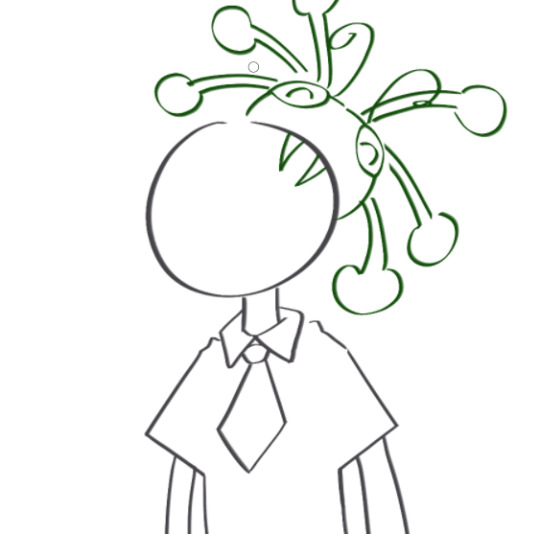
and that's it :)
73 notes
·
View notes
Text
As an insect enthusiast and someone who will soon major in entomology...
*Another* reblog game!
Reblog with a picture of your F/O and I'll assign them an insect friend!!!

#insects#bugs#entomology#insect#f/o#fictional other#self insert#selfshipper#oc x canon#selfship#oc x f/o#safeship#safeshipping#f/o community#selfship community
63 notes
·
View notes
Text
I don't unfortunately have many unsettling things to say
an intro?? Yeah it's been always here lmao 🎷🦖
Read on anyways
Heyyy, I'm Dino I draw things 💥💥💥💚 I'm a freak person lol, I unintentionally say weird stuff sometimes and don't come at me please 🦖☝️
(please just call me Dino it has a reason why it's not Dinosaur haha)
Entomology and Zoology enthusiast🦋🪲🦖
I draws murder drones/furries/humanoids
And as much as it may seem, I am not a furry I've gotten mistaken as one many times but I never considered, they are cool though
What I use to draw: phone, Ibispaint, finger
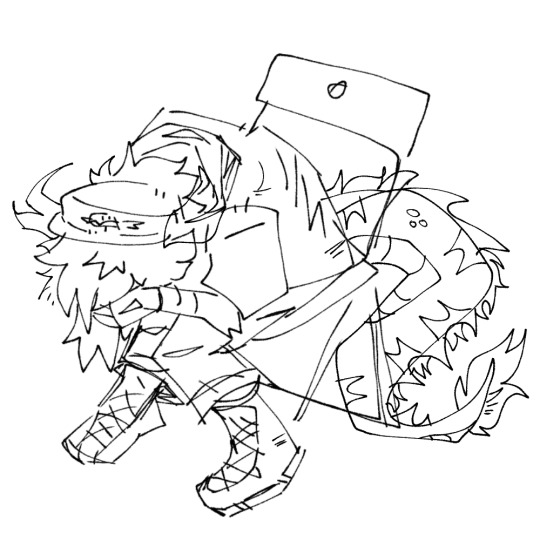

Drone-sona
Tags list
#/Dino stuff - casual talking, ranting, personal stuff
#/Dino's mutuals(art) - buddies, friends, mutuals
#/the weird Dinosaur talks about shit - shit posting
#/Dino roars- BATTLE CRY!!!!! / Important stuff
Dino reblogs - reblogging stuff that I like/love, giving compliments :D
#/Dino's favourites- holy hell I love this so much I'm going to screech on the floor do a back flip and die (usually seen with reblogs)
#/stashes- Keeping/saves for later (usually seen with reblogs)
#my art#art#the strange dinosaur dog draws#murder drones fanart#murder drones#intro#pinned post#pinned intro#murder drones oc#md diesel#md jay#md gasoline#md acetone#shitpost#anthro#furry art#protogen drones au#critter drones au#dino on crack#artist on tumblr
57 notes
·
View notes
Note
I am so glad I have found fellow entomology/bug enthusiasts!
Small question, I have heard the wonders of the fearsome snot weapon from a majestic creature called the "velvet worm". I was curious if you may enlighten us about this unique lifeform?
There are lots of bug lovers on tumblr so you came to the right place!
Your question is a bit vague, so I’m not sure exactly what you want to know about velvet worms. There’s a lot to know about them, and definitely too much to share unless you want to reply with a more specific question.
In the meantime let’s just admire one...

Pretty :) Ooperipatellus sp., photo by simongrove
185 notes
·
View notes
Text
PART TWO, ELECTRIC BOOGALOO. This one is from @commanderthalys's tag! Dunno who to tag for this one so whoever would like to do it.
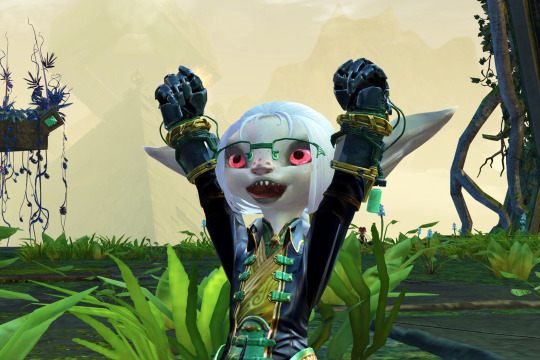
-- B A S I C S
Name: Qirri Tinkerfirst / Qirri of Pazz
Nicknames: Qiqi
Age: 15 at the start of the personal story, 26 currently
Birthday: 213 Scion 1309
Race: asura
Gender: female (cis), she/her
Orientation: Demisexual Demiromantic
Profession: Dragonwatch Krewe chief, Snaff Savant, Dynamics alumni genius first grade, pain in Rama's ass
-- P H Y S I C A L A S P E C T S
Hair: white
Eyes: pink
Skin: white (albino)
Tattoos/Scars: visible injection scars on her arms from blood draws and medical injections as a child
-- F A M I L Y
Family: Pazz (father), Tixzi (mother)
Siblings: Izza (older sister), Pyrria (older sister), Rissia (older sister), Garrus (adopted brother/bandmate)
Grandparents: unnamed
In-laws and others: Ahlma (cousin), Silas Dreadpyre (cousin-in-law), Taimi (girlfriend), Zanthe (boyfriend), Gorrik (boyfriend), Zojja (mentor)
-- S K I L L S
Abilities: Talented engineer and golemancer, known for vast array of invented medical aids.
Hobbies: Naps with Taimi, baking/cooking with Zanthe, practical entomology with Gorrik, having tea with Yao.
-- T R A I T S
Most positive trait: Extremely intelligent, clever, fast learner, enthusiastic.
Most negative trait: Bull headed, workaholic, smart mouth, easily frustrated.
-- L I K E S
Colors: Blue and gold.
Smells: That ozone smell after an experiment, the ginger green tea Yao makes
Textures: Anything that isn't too rough; always wears a soft gossamer tunic under her leather gear because of that.
Drinks: Water, peach juice, melon soda
-- O T H E R D E T A I L S
Smokes: absolutely not
Drinks: no (it interferes with her medication)
Drugs: only the ones she's prescribed
Been arrested: once, by Rama, while unconscious, and she has NEVER let him forget it
18 notes
·
View notes
Text

Wenvier Bingo - Professors
Thank you @heavenlyvixen for being a sounding board for my ideas. I wouldn't have the inspo for this without you. I'm sure some of the dialogue will seem familiar. 😜
Eugene was buzzing with excitement to attend Innsmouth University. It was the premier school for melittology with a focus on apiology, a branch of entomology. He found his people in the science department, and although he got tired of repeating and dumbing down what his field of study was for his degree, he was able to succinctly tell people:
“I’m gonna study honeybees.”
If it were up to him, he’d spend all his class time in the biology department or working in the apiary club called the Hummers.
But alas, Innsmouth had a general studies requirement and encouraged students to be “well rounded.”
So, he took a painting and a creative writing course.
The two professors could not be more different.
Professor “Call me Xavier” Thorpe taught Intro to Painting. Professor Thorpe, Eugene was never going to call a Professor by their first name as it was ingrained in him since private preschool to never be so informal with a teacher, was talented and knew what he was talking about when it came to colour theory and technique.
But he was the most unserious professor Eugene had ever come across.
Professor Thorpe wore camo pants to class, he was often mistaken for a student by other members of the faculty, invited his students to picnics on the quad, and often took the class on field trips to art museums where he wasn’t afraid to get down and dirty to kneel or squat when enthusiastically educating them on the artwork.
Even for the decorative molding which wasn’t technically part of the exhibit, Professor Thorpe saw art in everything.
Eugene could admire and respect the love of art Professor Thorpe had…but was baffled when the professor was found asleep on one of the art exhibits on campus and he wondered how he kept his job.
Then there was Professor Addams. She never offered for anyone to call her by her first name, but she was the type of severe teacher that Eugene was convinced she didn’t have a first name. Her name was Professor Addams, and no one could tell him otherwise.
She taught creative writing and specialized in the macabre and mystery genre. She even had a popular series based on a heroine named Viper de la Muerte. He was surprised she was even teaching as there was a rumour on campus that she had just gotten movie deals for her series.
Professor Addams was the consummate professional. She was always pristinely dressed and well put together, and she put the fear of God into her students. So much so that they jokingly said The Devil Wrote Mystery Novels, and when she walked across campus, people got out of her way.
One day, when someone said she was married to Professor Thorpe, Eugene literally laughed out loud and went about his classes. When others tried to convince him that the beautiful creative writing professor was married to the goofiest teacher Eugene ever had, he laughed again.
It wasn’t until he saw them kissing under a gnarled oak tree on the quad, did he finally give credence to the rumours.
“How in the hell are those two married?” he asked his classmates while at the art studio, before Professor Thorpe arrived. He would never have done it in Professor Addams’ class, too afraid she might accidentally overhear.
He looked around, paranoid she may be around the corner.
“I know, right?” Pugsly could only laugh as it was a ridiculous thought. “They’re so opposite of each other.”
“And not just in demeanor and how they dress,” Yoko added, “He’s a tall and she’s a smol.”
The class laughed as they got their supplies together.
“She’s like a tiny koala and he’s a eucalyptus tree,” someone else commented.
“Yeah, I bet she climbs him like a tree,” Yoko said suggestively. That was when the girls in the class heartily agreed and giggled.
Eugene just rolled his eyes. While he thought Professor Thorpe was goofy as hell, many of the women on campus swooned over his 6' 2" height, dreamy green eyes, and heart stopping dimples.
Their words, not his.
Despite his bafflement at their relationship, they both ignited a love for the arts in him. After that semester, he decided to double major in writing and did painting as a hobby.
The Hummers’ beehives were treated to a makeover and had never been as colourful and beautiful.
He happily consulted with Professor Addams on how one might die from a swarm of honeybees for her next novel.
He gave both professors excellent reviews on RateMyProfessor.com.
Card under cut
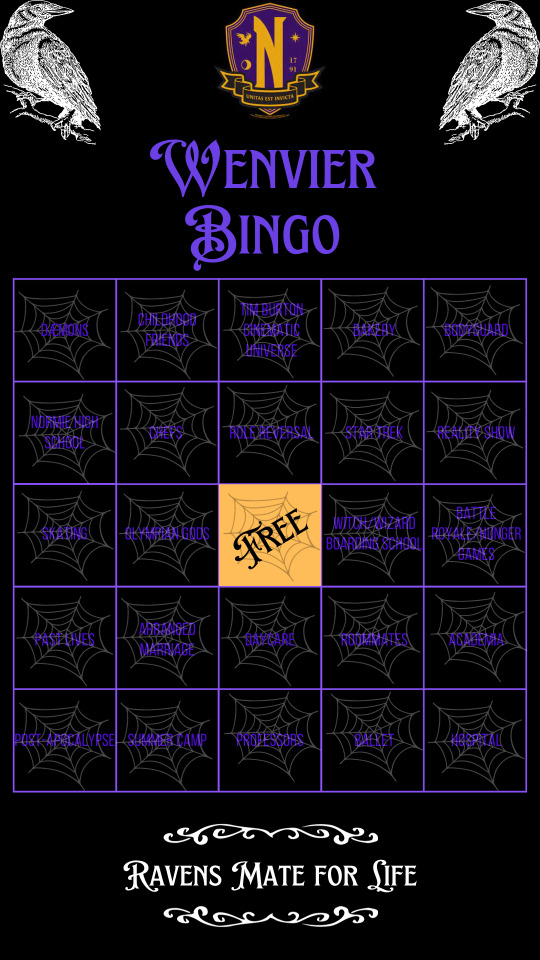
#wenvier#wenvier bingo#wenvier moodboard#wednesday addams#eugene ottinger#xavier thorpe#wednesday x xavier#bingo blackout#holy shit I did it!
22 notes
·
View notes
Text


Before and after dropping your friend off at the airport.
[ID: Two different walk cycles of the same 3D scorpion character with a chair and corked jar on its back and an umbrella tied to its stinger. In the first cycle, there is a potted cactus character sitting in the chair and holding the scorpion's reins; they're traveling very quickly and everything's jiggling. In the second cycle, the scorpion is alone with its reins draped across the chair; it's ambling at one third the speed of the first gif (two meters per second versus six, captured in a twelve frame walk cycle instead of eight) and while its cargo and decorations sway, nothing shakes. End ID]
I'm finally rendering the animation at full resolution (Shot C: complete; Shot B: 16 more frames; Shot A: hard to determine because it takes ages per frame so I'm using EbSynth where possible but there are at least 30 more frames before compositing) -- which means we're on to prep for the breakdown showoff video and I finally got this buddy a walk cycle slow enough the front legs have more than a single frame for passing from front to back. So luxurious!
Character concepts by Nicholas Kole.
#cj gladback#enthusiastic entomology#blender#wip animation#3d wip#the vod collection is now at 83 videos and just a couple minutes shy of 240 hours#but if i had a super computer i'd have had the animation rendered in august and i think that's pretty good#this newer slower walk cycle might still get improvements on the umbrella but intentionally doesn't key the face or claws#so if i want i can use NLA for acting even before a final action after the layers of objects have all faded in
2 notes
·
View notes
Text

This is a 28.
Normally I'm all about entomology; here is some etymology. (Note I'm not an expert, just enthusiastic)
Names by language of origin:
28; French (probably) because it's call sounds like "vingt huit", 28 in French.
Toolnut; Noongar, also based on their sounds. (Noongar elder Vernice Gillies)
Dowarn, Doomolok; Noongar names. (Abbott, Ian, 2009)
Ringneck; English, a visual description.
Or, 28; English, because people say the call sounds like 28 in English... I don't think it does.
Sky Edwards
2023
Donnelly River Village
Canon R7
Canon EF 100-400 L IS USM
#28#ringneck parrot#28 parrot#australianbirds#australianwildlife#parrots#etymology#language#noongar#birdphotography#donnelly river village
11 notes
·
View notes
Text
Carnation


The carnation means fascination, distinction, and love. According to a Christian legend, carnations grew from the Virgin Mary's tears as she watched Jesus carry the cross. This is how they became associated with motherly love.
Know more about amazing carnation
Carnation
Dianthus caryophyllus
ALSO KNOWN AS
Clove Pinks, Angelier (Afr.), Border carnation, Clove pink, Cottage pink, Divine flower, Gilly flower, Picotee
Carnation is the birth flower for those born in the month of January.
Carnation Symbolism & Colors
Carnations grow in a wide variety of colors including pink, white, red, yellow, and scarlet. They are popular flowers for dying, so if you can’t find a natural color you like you can create it! Each color has a different meaning.
White carnations symbolize purity and luck.
Light red carnations symbolize admiration.
Dark red carnations symbolize love and affection.
Pink carnations symbolize gratitude.
Yellow carnations symbolize disappointment or rejection.
Purple carnations symbolize capriciousness.
Traditions and history
In France, purple carnations are the traditional funeral flower.Carnations are given on 1st anniversaries as a sign of love and commitment.They’re the second most popular cut flower after roses.
Carnations are the national flower of Spain and Slovenia.Since Ottoman times, red carnations and tulips are used in the interior wall paintings of mosques in Turkey. It is often said that while tulips represent God, carnations are the symbol for prophet Muhammad .{peace be upon him}
Carnations were mentioned in Greek literature 2,000 years ago. The term dianthus was coined by Greek botanist Theophrastus, and is derived from the Ancient Greek words for divine ("dios") and flower ("anthos"). The name "carnation" is believed to come from the Latin corona-ae, a "wreath, garland,
The formal name for carnation, dianthus, comes from Greek for "heavenly flower", or the flower ofCarnation Cultural Significance.
Carnation in poets
Carnations have inspired many artists, poets, and authors. British composer Joseph Mazzinghi wrote a song entitled “Ye Shepherds Tell Me”, which told of a beautiful girl wearing a wreath of flowers.
A wreath around her head,
Around her head she wore,
Carnation, lily, lily, rose,
And in her hand a crook she bore,
And sweets her breath compose.
Esteemed artist John Singer Sargent was influenced by this song, and created a painting entitled Carnation, Lily, Lily, Rose, which depicts two girls playing with lanterns in the garden.
Carnation in cooking
Edible
A spicy, floral taste. Ideal for adding to cakes or for use as decoration. Could be used as a colourful garnish to add to soups or salads.
Carnation overview
Dianthus caryophyllus is also known by the common name carnation. Historically this species has been cultivated for more than 2000 years. It is used medicinally, cosmetically, culinarily and as an insect repellant. The fragrant flowers are a favourite in many gardens, they make lovely cut flowers and are even listed in the top 10 cut flowers of the world, to grow at home!
Special features of Carnation
Nectar attracts butterflies and bees.
HOW TO HARVEST CARNATION
Deadhead flowers to keep this carnation blooming longer. Cutting side flower shoots will encourage the central bud grow into a larger flower.
Description
Dianthus caryophyllus is a herbaceous perennial plant growing up to 80 cm (31+1⁄2 in) tall. The leaves are glaucous greyish green to blue-green, slender, up to 15 cm (6 in) long. The flowers are produced singly or up to five together in a cyme; they are around 3–5 cm (1+1⁄4–2 in) diameter, and sweetly scented; the original natural flower color is bright pinkish-purple, but cultivars of other colors, including red, white, yellow, blue and green, along with some white with colored striped variations have been developed.
SPECIAL FEATURES OF CARNATION
Attracts useful insects
Nectar attracts butterflies and bees.
Attracts birds
Fragrant flowers attract nectar feeders like hummingbirds and insect eating birds too.
Facts about carnation
Purple carnations indicate capriciousness. In France, it is a traditional funeral flower, given in condolence for the death of a loved one.Carnations are often worn on special occasions, especially Mother's Day and weddings. In 1907, Anna Jarvis chose a carnation as the emblem of Mother's Day because it was her mother's favourite flower. This tradition is now observed in the United States and Canada on the second Sunday in May. Ann Jarvis chose the white carnation because she wanted to represent the purity of a mother's love. This meaning has evolved over time, and now a red carnation may be worn if one's mother is alive, and a white one if she has died.
Where carnation found
The wild carnation is found in the Mediterranean countries of Spain, Italy, Croatia, Albania, Greece and Turkey.
Know more about any flower??? Just Ask me !!!!
#flowers#floral#flora and fauna#flora#florist#flower knows#flower lovers#carnation#carnation flower#amazing facts#amazing#flower garden#anthophile#botony#flower magic#earth magic#encyclopaedia#entomology#enthusiasm#enthusiastic#encyclopedia#encyclopédie#pink floral#pink flowers#knowledge#explanation#explained
22 notes
·
View notes
Text
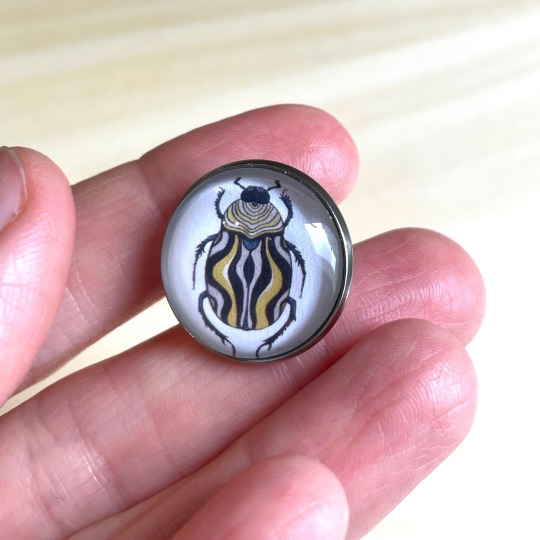
A beetle brooch with my art. Comes in a set of 4 different beetles.
#artists on tumblr#illustration#etsy#etsystore#etsyfinds#brooch#jewelry#pins#handmade#handmade jewelry#maker#beetle#insects#insect#bugs#entomology#goblincore
12 notes
·
View notes
Text
The American Ornithological Society, the organization responsible for standardizing English bird names across the Americas, announced on Wednesday that it would rename all species honoring people. Bird names derived from people, the society said in a statement, can be harmful, exclusive and detract from “the focus, appreciation or consideration of the birds themselves.”
That means the Audubon’s shearwater, a bird found off the coast of the southeastern United States, will no longer have a name acknowledging John James Audubon, a famous bird illustrator and a slave owner who adamantly opposed abolition. The Scott’s oriole, a black-and-yellow bird inhabiting the Southwest and Mexico, will also receive a new moniker, which will sever ties to the U.S. Civil War general Winfield Scott, who oversaw the forced relocation of Indigenous peoples in 1838 that eventually became the Trail of Tears.
The organization’s decision is a response to pressure from birders to redress the recognition of historical figures with racist or colonial pasts. The renaming process will aim for more descriptive names about the birds’ habitats or physical features and is part of a broader push in science for more welcoming, inclusive environments.
“We’re really doing this to address some historic wrongs,” said Judith Scarl, the executive director of the American Ornithological Society. Dr. Scarl added that the change would help “engage even more people in enjoying and protecting and studying birds.”
Advocates of this change believe that many English common names for birds are “isolating and demeaning reminders of oppression, slavery and genocide,” according to a petition in 2020 that was addressed to the American Ornithological Society. The petition was written by Bird Names For Birds, an initiative founded by two ornithologists to confront the issue of these bird names, which it describes as “verbal statues” reflecting the values of their eponyms.
But some birders, while expressing sympathy for the cause, said that they were unsure that this was the right route to take. “I’m not super enthusiastic about it, but neither am I super disappointed about it,” said Jeff Marks, an ornithologist at the Montana Bird Advocacy.
“We’ll lose a little bit of knowledge about some key people in the history of ornithology, and that saddens me,” Dr. Marks said. “But maybe in the scheme of things that’s just not that big of a deal.”
Jordan Rutter, a founder of Bird Names For Birds, said the petition was inspired by what became a momentous encounter in Central Park in 2020, when a white woman falsely reported to police that Christian Cooper, a Black birder, was threatening her.
The Central Park encounter inspired the creation of Black Birders Week, an annual campaign to celebrate the lives and careers of Black birders, which then spurred an avalanche of similar initiatives in the sciences against the backdrop of a nationwide racial reckoning. In 2021, the Entomological Society of America began the Better Common Names Project to change the names of insects deemed inappropriate or derogatory. Astronomers have also advocated for the renaming of major telescopes that they say alienate people from marginalized backgrounds.
In birding communities, pushes to move away from problematic bird names have produced mixed results. The Bird Union and the Chicago Bird Alliance recently changed their names to avoid an association with Audubon. But the board of directors at the National Audubon Society voted to retain its name this year, saying that the mission of the organization transcended the history of one person.
In 2022, the American Ornithological Society announced the formation of an ad hoc committee to determine how to address controversial bird names. Members of the committee met every two weeks for months, discussing topics such as the importance of name stability and how to determine the criteria for changing a bird’s name.
Wednesday’s announcement is the culmination of that effort. In its statement, the American Ornithological Society committed to changing all bird names derived from people and assembling a diverse group to oversee the renaming process, which it said would include input from the general public. More than 100 avian species across the Americas will be given new names.
“The idea of changing a bunch of names is, to many people — myself included, originally — throwing out a lot of history,” said John Fitzpatrick, an ornithologist at Cornell University. He said that he initially felt bird names should be evaluated on a case-by-case basis but that further discussions convinced him that “there is no formula by which we can figure out which names are good enough.”
Notably, only the common English names of birds will change, since scientific names — which are traditionally in Latin — are governed by a rigid, universal set of rules that take into account evolutionary relationships between different species. (Latin designations taken from people’s names exist as well, such as Capito fitzpatricki for the Sira barbet, a Peruvian bird named after Dr. Fitzpatrick.)
The decision to change common names of birds “makes perfect sense” to Mr. Cooper, whose fame has led him to hosting a National Geographic birding show. “There’s no reason to have a person’s name attached to a bird, because it doesn’t tell you anything about the bird,” he said.
Mr. Cooper mentioned the Wilson’s warbler, a canary songbird with a characteristic black cap. Changing the name to something “like black-capped warbler,” he said, would give birders a better idea of what to look for.
But to Jerry Coyne, an evolutionary biologist at the University of Chicago who is an avid birder, the need for more descriptive names did not seem pressing. Performative acts like this “are really deeply injurious to science,” he said. “We cannot go back through the history of science and wipe out everybody who was not a perfect human being.” Dr. Coyne added that the effort to update so many names would be better invested in something more impactful to society, such as teaching underprivileged children about birds.
The American Ornithological Society plans to pilot a renaming program next year, starting with around 10 birds. Eventually, the program will expand to address all namesake birds in the United States and Canada, and then move on to avian species in Central and South America, which is the extent of the society’s naming jurisdiction.
Carlos Daniel Cadena, an ornithologist at the University of the Andes in Colombia and a leader of the English Bird Names Committee, expects the changes to entail a slight learning curve but also present a new opportunity for the public to bond over birds.
“It’s going to be a level playing field where we all need to learn together,” Dr. Cadena said.
He noted that the process might be adjusted for birds in Latin American countries, where people commonly refer to them by their scientific names.
With thousands of species across the Americas, birds are as diverse as the communities that cherish them. “Birds are by far the most accessible and beloved feature in biodiversity worldwide,” said Dr. Fitzpatrick. He added that more colorful names for these creatures would heighten “the ease by which new birders of every stripe” can enjoy them.
14 notes
·
View notes
Text
I am a mystery reader
Or, Why I Read Forensics by Val McDermid
For the past year, I’ve been inhaling mystery novels to learn about the genre. I often engage with intense genre studies when I have an interest in writing within particular story conventions. It’s always fun and I get to learn about an amazing world of books that I don’t normally pick up.
For most of 2023, it’s been mysteries. And, I can confidently say that I’m now a big mystery reader. I’m obsessed with it. I shouldn’t have been surprised. The clues have been there since the beginning.
I’ve always loved stories with mystery elements to them. I wrote a thesis comparing and contrasting TV/movie adaptations of Sherlock Holmes and the original short stories. Most of the podcasts that I enjoy are true crime because I love learning the details of specific cases, and how certain clues or slips led to the apprehension of the perpetrator. But it wasn’t until 2023 that I would’ve classify myself as a “mystery reader.” I can be really thick-headed, if you couldn’t tell.
Horror reader, sure. Detective enthusiast, you betcha! True crime addict, guilty.
There are so many things that makes a mystery, a mystery. They include, but are not limited to:
Your killer and their motives
Your detective and their unique skill set that makes them best suited (or most motivated) to find said killer
The clues, the false leads, and the red herrings
And most importantly, that the killer is caught: unmasked by the detective. If it doesn’t have this particular element, it’s not a true mystery. (Not to discount genre blends which I adore and champion).
Forensics: What Bugs, Burns, Prints, DNA, and More Tell Us About Crime by Val McDermid goes into the more technical aspects of solving a crime. There’s an umbrella of fields under forensics from DNA to facial reconstruction to forensic psychology to entomology. All these discipline work to make the sequence of events and the truth of the crime clearer in the context of the courtroom.
I picked up this book because I wanted to learn more about all these disciplines. Its filled with countless case studies throughout the centuries, tracking the development of new techniques and their limitations. Val McDermid, who is a veteran of the genre (I’ve read the whole of her Allie Burns series this year and intend to read more), explains all this in a very approachable way with interviews from professionals in every field she covers.
This is a must read for everyone who wants a comprehensive introduction to forensics for either bulking up their knowledge for their own mystery or they just genuinely find the science fascinating (Hello! I am both).
7 notes
·
View notes